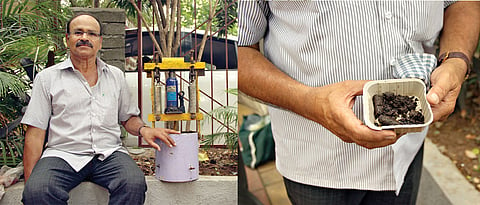

Vaibhav Modak was inundated with emails, phone calls and letters from farmers eager to learn about the compact organic fertiliser technology he had developed. Among them stood out a letter from an 85-year-old farmer. The man wanted to learn about organic fertilisers but his age prevented him from travelling to Mangalvedha village in Solapur district where Modak lives. The farmer’s burning desire to learn moved Modak so much that he finished a book about his technology in just 15 days! The book was released on June 5.
The heart of the book is the equipment and technology Modak has developed to make and deliver compact organic fertiliser. Apart from this, Modak writes about several farming topics like herbicides, land grab, other innovations like fire resistant huts for cattle, and more. He writes about farmer suicides too and the book is dedicated to the farmers who committed suicide. “Let us now end the thought of suicide”, his dedication reads.
But don’t mistake this innovator for a researcher, engineer or scientist.
The 65-year-old is a farmer who barely leaves his fields. Modak developed this technology over eight years, and the current machine is the eighth model after several trials and changes.
The simple machine delivers compact pellets of organic fertiliser. The pellets are made from a mixture of cow dung, poultry fertiliser, goat manure, powdered neem seeds, and the mud under the tree where animals are tied. “This mud is enriched because of the animal excreta that has been deposited there for years together, and no one thought of using it!” said Modak. The idea is to make use of ingredients available to the farmer so that he is not dependent on the market.
And this is how Modak has developed his technology, through keen observation, experience and research. The former state consultant for agriculture Dr Ramchandra Sable believes it will change the direction of farming. “It will reduce input costs for the farmers. But that’s not all.
Modak meticulously shows the placement of the organic fertiliser, which is a very important aspect,” said Dr Sable. The fertiliser generated from Modak’s machine must be placed at the base of the crops for maximum benefit, rather than spreading it all over the field as traditional practices dictate. Focussed use also keeps the cost of the fertiliser down to about Rs 400 for an acre.
The pellets, because of which the fertiliser is described as compact, also have the ability to slowly release moisture. Due to this feature the fertiliser is targeted at kharif crops (crops that are grown in the monsoon and are dependent on rain). If the rains play truant, the fertiliser should take care of supplying the crops’ water requirement, said Modak. He uses the compact organic fertiliser for all his kharif crops like jwari, harbhara, kardai and sugarcane. But he believes the fertiliser can be used for any kind of crop; the only crucial aspect will be how the farmer delivers it to the crop.
The other feature of the fertiliser is its ability to carry other elements that the soil lacks, which can be easily ascertained by making a health card of the soil. “If you mix the micronutrients with the fertiliser, it’ll give a way out from chemical fertilisers,” said an enthusiastic Modak. He also believes the fertiliser can increase the carbon content of the soil.
But he also has cautionary advice. “Even while switching to organic, the farmer must do it gradually. A sudden change will cause the yield to plummet, but changing over to organic fertilisers by slowly reducing the proportion of chemical fertilisers used is a good strategy,” he said, adding that as the toxicity of the soil reduces, the yield begins increasing.
He now wants to take the technology to many more farmers, and also train them in its use. He wants universities to begin teaching farmers how to make and use this fertiliser, which will take the technology far and wide.
